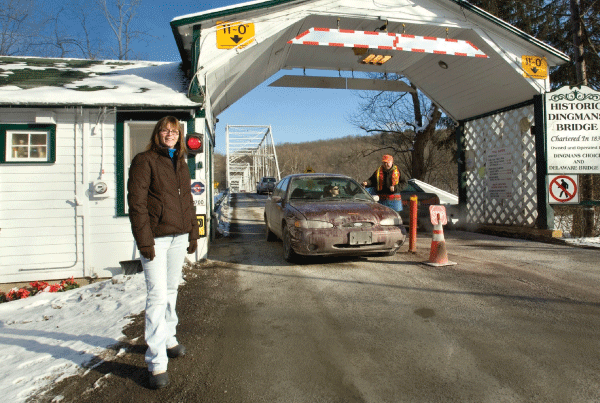
Dingmans Bridge serves millions of drivers each year, despite its, well, peculiarities.
No one would blame a driver crossing Dingmans Bridge for inquiring about the
E-ZPass lane or, more precisely, the lack of it.
“It’s probably the most common question we get,” says Paul Hutera, who has been collecting tolls by hand for twelve years for this 530-foot Delaware River span, the last privately owned toll bridge on the river.
The absence of E-ZPass is not the only peculiarity that awaits drivers crossing Dingmans Bridge, which connects Route 560 in Layton with Route 739 on the Pennsylvania side.
The two-lane bridge, owned and operated by Dingmans Choice and Delaware Bridge Company, is narrow—a mere 18 feet wide, which makes passing a car going in the opposite direction a decidedly nerve-wracking affair. What’s more, the bridge’s deck is made of individually bolted wood planks that go clickety-clack as traffic moves over them, a sound some drivers find unsettling.
The old-fashioned joy of crossing Dingmans Bridge can be a little more expensive than using one of New Jersey and Pennsylvania’s jointly operated bridges over the Delaware, including the Milford-Montague Toll Bridge, about eight miles up river. For autos, the base rate on the latter bridge is 75 cents, which is collected westbound only—with cash or E-ZPass. The Dingmans Bridge toll is $1 and is hand-collected on the Pennsylvania side from cars going in either direction. (Commuters can purchase a 40-ticket packet for $20.)
Most drivers don’t seem bothered by the private bridge’s quirks. In a typical year, some 1.85 million cars and other smaller vehicles make the crossing, according to Carol Philips, the company’s secretary/treasurer. That compares favorably with the annual traffic moving across the longer and wider Milford-Montague bridge, which in 2007 served about 3 million vehicles.
Why are so many drivers loyal to Dingmans Bridge? First, many find it more convenient than the Milford bridge.
Others are drawn by the uncommon opportunity to interact with the eighteen part-time toll-takers. Working in pairs, with one standing outside, the other in the cramped toll shack, they offer expert directions, advise travelers about local recreational spots, and engage in a running stream of good-natured banter. Toll-taker Karen Cahill, a self-proclaimed animal lover, keeps a supply of biscuits on hand for cars carrying dogs.
“Their heads are out of the window as soon as they see me,” says Cahill, who has been at her job for nine years.
The current Dingmans Bridge, erected in 1900 using three wrought-iron railroad trusses, is the fourth bridge to occupy the site. Various problems—from floods to shoddy construction—caused the three preceding bridges to collapse. Even before there was a bridge, a local settler named Andrew Dingman ran a flat-boat ferry service at the site beginning in 1735. The first bridge—a covered, wooden span—went up 100 years later.
Besides undergoing routine maintenance, the current bridge is inspected top to bottom each year by an engineering firm. Any findings are addressed after Labor Day, when the bridge may close for up to a week or more. Today, notes the company’s website (dingmansbridge.com), the bridge is probably “in even better shape” than when it was built.
Still, toll-taker Hutera can’t help teasing nervous first-time crossers. “Haven’t lost anybody yet,” he’ll say with a mischievous smile, “but we’re due.”
Wayne J. Guglielmo is a Mahwah-based freelance writer.
To read more stories from our Waterfront Getaways issue, click on the links below:




It has nothing to do with loyalty. They’re the only game in town unless you want to take an extra twenty minutes to go north to the Milford bridge, only to turn around and come back down south. And it’s more that $20 a book now; it’s $30. At 1.85 million cars, charged each way, that’s well over $3 million a YEAR yet, they keep raising the tolls because they know that the locals (99% of the bridge traffic) who work in Jersey have no choice.
How does one walk /hike across the dingman bridge? or are pedestrians even allowed to? Maybe they should build a pedestrian bridge for hikers. across there as well??